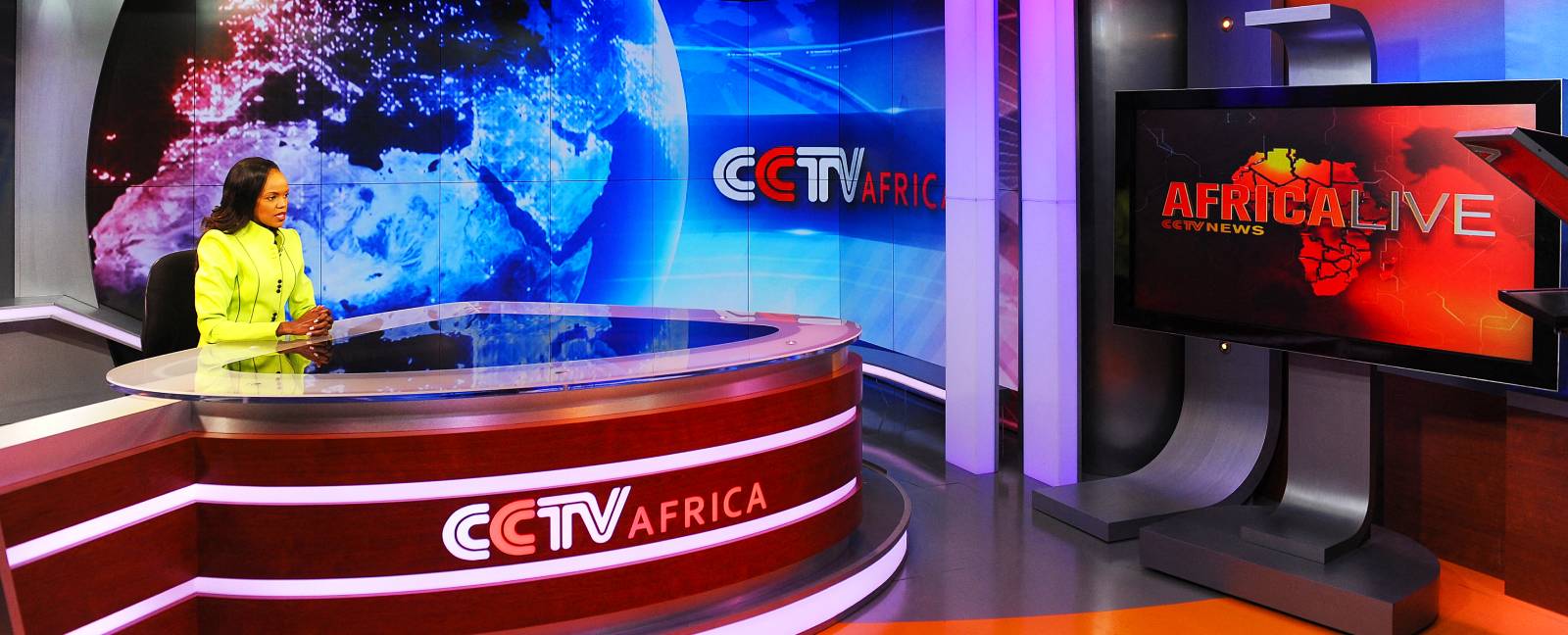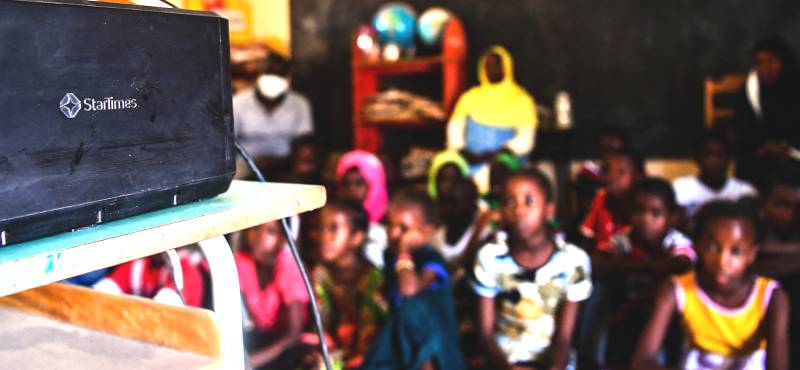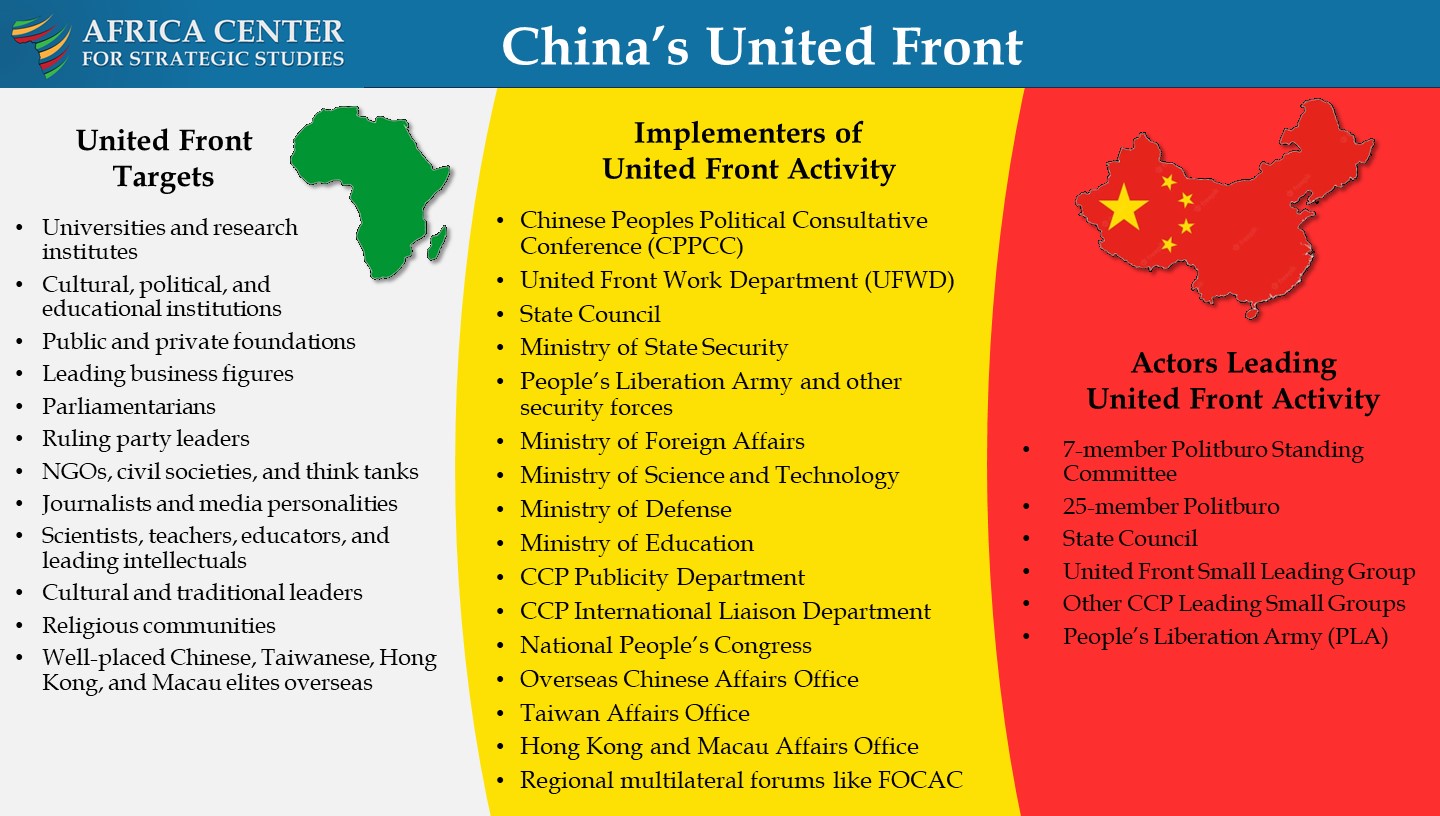
News presenter Beatrice Marshall at China Central Television (CCTV) Africa’s studio in Nairobi. (Photo: Simon Maina/AFP)
A key pillar of China’s efforts to gain influence in Africa and globally is to create impressions of universal support for the Chinese Communist Party (CCP). Central to this is the political strategy known as the “United Front” (tŏngyī zhànxiàn; 统一战线) to mobilize individuals and institutions outside the Party and around the world to advance the interests of the CCP and isolate its adversaries.
Targets of United Front influence include private sector leaders, public intellectuals, influential foundations, lawyers, media, academia, think tanks, civil society organizations, political parties, youth and women, entrepreneurs, and retired heads of state. Very few United Front organizations have direct connections to the CCP. This makes drawing their associations less obvious. United Front activities support the objective to secure the CCP’s domestic survival and turn China into a global military and economic power.
Independent pollsters suggest that China’s strongest support and appeal around the world comes from Africa, where the receptiveness to Chinese views, positions, and experiences are highest. Hence, China invests heavily in procuring Africa’s goodwill to buttress its global endeavors. The consistent backing African countries give China at the United Nations and other global bodies is one outcome of these efforts.
The CCP relies on a predominantly regime-centric strategy premised on cultivating, supporting, and entrenching governing elites and … target China’s opponents.
The CCP relies on a predominantly regime-centric strategy premised on cultivating, supporting, and entrenching governing elites and their allies outside government. Accordingly, African actors closer to the centers of political power tend to be highly defensive of China and fiercely critical of its opponents. China’s United Front work simultaneously aims to shape wider public opinion. Through increased engagement with African educational institutions, research centers, cultural organizations, and media outlets, the CCP seeks both to disseminate China’s positive image and to counter what Chinese public relations officials often call the Western demonization of China.
Some African observers call China’s regime-centric strategy a “see no evil, hear no evil” approach where regimes receive unqualified Chinese support even when they lack domestic popularity. Hence many African stakeholders—especially those in civil society and democratic movements—accuse the CCP of reinforcing authoritarian and unaccountable governance which breeds impunity. Critics raise concerns about the impact of China’s broader United Front activities on media professionalism, academic independence, and commitment to democracy—potentially distorting the public’s interpretation of news and key events.
Machinery of the United Front
The United Front coordinates hundreds of thousands of loosely organized United Front individuals and organizations to expand China’s circle of “friends,” turn “neutrals” into “friends” or keep them indifferent, and divide “enemies.” United Front work exists to ensure that the CCP’s power is not undermined. Among its core tasks is combating what the CCP calls “false ideological trends” that threaten it: liberal constitutional democracy, Western political values, promotion of civil society, neoliberalism, historical nihilism, Western concepts of journalism, and the questioning of China’s political system. These were identified in a seminal document, “Communique of the Current State of Ideological Sphere,” in 2013, a year after Xi Jinping took the helm.
Among its core tasks is combating what the CCP calls “false ideological trends” that threaten it: liberal constitutional democracy, Western political values, promotion of civil society, … and the questioning of China’s political system.
The United Front Work Department (UFWD) and Chinese People’s Political Consultative Conference (CPPCC), which works with political, educational, and cultural organizations in 39 African countries, are the two principal organs that have historically been affiliated with the United Front. However, the UFWD draws on other CCP institutions like the CCP International Liaison Department (ILD) that works with political parties in 51 African countries, the National People’s Congress (NPC), which has official relations with 35 African parliaments, and the China Association for International Friendly Contact (CAIFC), which helps conduct military diplomacy. The latter is controlled by the Political Work Department of the CCP Central Military Commission that runs the People’s Liberation Army (PLA). Similarly, the All-China Journalists Association partners with the Federation of African Journalists, which has 150,000 members. It organizes exchanges for hundreds of African journalists annually. If just a fraction of these leave China with positive impressions, then the UFWD would consider that a win.
The United Front system is like an onion with its many layers. The inner core consists of those who lead different parts of the United Front system. The first layer consists of party, state, and security agencies that implement influence operations under the United Front umbrella. The outer layer consists of target groups. The UFWD itself is organized into 12 bureaus. Its African engagements are coordinated by the 9th and 10th bureaus, which also cover overseas Chinese affairs.
What Does United Front Work Look Like?
China’s vaccine diplomacy during the COVID-19 outbreak illustrates the CCP’s multifaceted United Front activity. In December 2020, China sponsored a visit by 50 African diplomats to China’s state-run vaccine manufacturer, Sinopharm, to push back against criticism about the safety of Chinese vaccines. Rwanda’s ambassador said he felt “reassured” after the visit. Sierra Leone’s ambassador praised China for ensuring that “Africa was well and safe.” By February 2021, nearly 40 African countries ordered Chinese vaccines. During the rollout, South African President, Cyril Ramaphosa accused wealthy nations (excluding China) of “hoarding.”
This was echoed in May 2021 by Wu Peng, the Director-General of the Department of African Affairs at China’s Ministry of Foreign Affairs, when he said “some countries” vaccinated their people before others, an apparent dig at Western powers.
The CCP’s media industry in Africa published a flood of stories extolling China’s efforts to reduce “the shocking vaccination gap.” These stories also questioned the safety of Western vaccines and were crafted to resonate with perspectives voiced by senior African leaders and opinion makers in both overt and subtle ways—indicating what a United Front operation looks like in real time.
Like spokes of a wheel, numerous institutions were involved in promoting China’s messaging:
- The People’s Liberation Army (PLA) held virtual dialogues with their African counterparts to reinforce the sharing of China’s experience in combating COVID.
- China’s foreign ministry organized African visits to Sinopharm and other facilities.
- The Jack Ma and Alibaba Foundations, which have no direct links to the CCP or Chinese government, distributed Chinese vaccines and medical equipment to African countries.
- The CCP-owned People’s Daily published numerous stories showcasing China’s funding and construction of the African Centers for Disease Control (ACDC) building.
- The China Africa Media Cooperation Forum, an organ of the Forum on China-Africa Cooperation (FOCAC), funded exchanges for African newscasters aimed at using digital tools to “counter misleading Western narratives on COVID-19.”
- The China Africa Press Center, a collaboration between China’s foreign ministry and Renmin University, sponsored African journalists to write favorable stories, mostly through pre-existing content-sharing agreements with African private and state media.
Despite China’s claims and subsequent promotion, by mid-2022 over 90 percent of the 2.4 billion vaccines provided to COVAX, the multilateral initiative established to facilitate vaccine access in low- and middle-income countries, were from Western countries. In contrast, the doses China supplied to COVAX were primarily for purchase. Africa received less than half of the modest 18.5 million doses Beijing donated worldwide. Moreover, China had only provided 21 percent of the vaccines that it had pledged to COVAX.
This illustration shows that China’s United Front thrives on creating impressions and assumptions and getting target audiences to amplify Chinese points of view and neutralize opposing ones. To this day, the widely held assumption in Africa is that China supplied more vaccines to the continent than other countries.
China’s United Front thrives on creating impressions and assumptions and getting target audiences to amplify Chinese points of view.
Other areas of United Front work can be seen in efforts to draw respected retired leaders into CCP-sponsored high-level international initiatives and provide support for their activities, which often play an influential role in the politics of their countries.
The PLA’s activities are also coordinated closely with United Front work to test public opinion and reaction, build popular support, and reduce potential opposition. For example, the opening of China’s military base in Djibouti in 2017 was preceded by several years of coordinated economic, political, military, and development activities aimed at overcoming the African Union’s longstanding aversion to foreign basing.
Notably, the base was opened less than a year after the AU issued a strong statement warning member states to avoid arrangements that would result in more bases in Africa. That is yet another example of what United Front influence looks like on the ground.
Shaping the African Media Environment
The CCP’s capacity to shape information ecosystems plays a critical part in its United Front work. The China Africa Press Center hosts an annual 18-month media fellowship for African journalists in different Chinese institutions. Its alumni often hit back at accusations against China in the foreign and African media.
Reporting out of the Nairobi-based China Global Television Network (CGTN), 150 Kenyan journalists dispatch 1,800 stories monthly. This bureau is the largest Chinese news outlet outside Beijing. Xinhua meanwhile has the largest foreign correspondent network in Africa. Its content-sharing agreement with the Nation Media Group—one of several in Africa—gives it access to 8 radio and television stations in 4 East and Central African countries, 28 million social media followers, 11.3 million monthly viewers, and 90,000 daily newspaper circulations.

Students in Senegal watch satellite television provided by Chinese media company StarTimes. (Photo: Li Yan/Xinhua via AFP)
StarTimes, Africa’s second largest digital television provider, distributes content to 10 million subscribers in 30 countries. From their African hubs, China Daily, China Global Television Network, and China Radio International release daily African content, the former two in local languages. These stories are designed and delivered almost exclusively by African journalists, making their Chinese messages less obvious.
Strengthening African Awareness and Resilience to United Front Work
A Chinese United Front campaign entrenches positive impressions among target audiences, relies on several instruments to influence policy and public opinion, and exploits opportunities to discredit opponents. The more local actors promote Chinese interests and discredit China’s opponents, the better for China as it can assert that its views are shared, not imposed. This legitimizes their validity and helps neutralize China’s competitors.
Joseph Odindo, the Chinese-educated former editorial director of the Nation Media Group noted that Chinese efforts to gain influence come with expectations. China bailed out another Kenyan media giant, the Standard Media Group, during his time as editorial director there. The Chinese embassy offered finance, equipment, training, and a well-paid supplement every 2 weeks focused on China stories. However, the deal fell through when the paper investigated corruption at the Chinese-funded Standard Gauge Railway. The Chinese Embassy canceled all their support and withdrew the supplement. “They demanded that we had to stop negative coverage,” said Odindo.
“The more local actors promote Chinese interests and discredit China’s opponents, the better for China.”
Beatrice Marshall, another Chinese-educated Kenyan journalist, formerly the Chief Anchor and Deputy Managing Editor of KTN, Kenya’s leading national television network, meanwhile, has suggested that China does not expect beneficiaries of its programs to propagate its interests. This illustrates the alternative narratives fostered by China’s United Front work.
Emerging best practices aim to counter negative aspects of Chinese influence in Africa while leveraging those that enhance African priorities. These include strengthening African agency by building knowledge about Chinese influence operations, standardizing popular oversight of agreements, consolidating independent institutions, pursuing strategic litigation, and sharing lessons on Chinese engagement.
All this is welcome given that the past decade has witnessed the steady growth of indigenous sites of research and knowledge on different aspects of Africa-China relations as evidenced by initiatives like the Africa-China Reporting Project, the Afro-Sino Center of International Relations, and the Chinese in Africa/Africans in China Research Network, which is the largest network of independent Afro-Sino scholars. Hence, there is growing capacity to conduct deeper research on Chinese engagements in Africa including United Front activities.
The tentacular nature of United Front work, sheer number of organizations at its disposal, and inherent difficulties in identifying and proving its networks make it a formidable tool to advance Chinese power and influence on many different levels. To better moderate these influences, Africans should invest more in empowering key segments of society, particularly media, social movements and organizations, and independent institutions with tools to better understand the features, methods, goals and actors responsible for achieving United Front work objectives. This will foster greater awareness, insight, mitigate against co-option, and maximize the more positive elements of Chinese engagement in Africa.
To use the words of an official of one NGO coalition, “ultimately an open press, vigorous democracy, and critical public engagement are the antidotes to co-optation and elite capture and also key sources of resilience to the capture of key individuals, institutions, and organizations.”
Additional Resources
- Africa Center for Strategic Studies, “China’s Influence on African Media,” Interview with Bob Wekesa, May 12, 2023.
- Paul Nantulya, “China’s Deepening Ties to Africa in Xi Jinping’s Third Term,” Spotlight, Africa Center for Strategic Studies, November 29, 2022.
- Nosmot Gbadamosi, “What Xi’s Third Term Means for Africa,” Foreign Policy, October 26, 2022.
- Mareike Ohlberg, “United Front Work and Political Influence Operations in Sub-Saharan Africa,” in Nadège Rolland, ed., “Political Front Lines: Chinas Pursuit of Influence in Africa,” NBR Special Report No. 100, National Bureau of Asian Research (June 2022), 7-24.
- Neil Thomas, “Proselytizing Power: The Party Wants the World to Learn from Its Experiences,” Macro Polo, January 22, 2020.
- Yun Sun, “Chinese Campaigns for Political Influence in Africa,” Testimony before the U.S.-China Economic and Security Review Commission, May 8, 2020.
- Nadège Rolland, “China’s Vision for a New World Order,” NBR Special Report No. 83, National Bureau of Asian Research, January 20, 2020.
More On: China in Africa Disinformation


